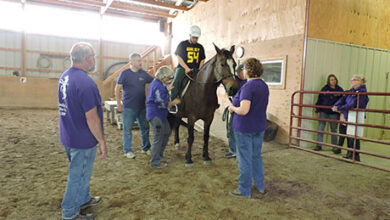Parma’s Lake Ontario beaches
by David Crumb, Hilton Historian
Part four of four
Ampor Beach
Ampor Beach was founded in 1907 by the Associated Master Plumbers of Rochester thus (AMPOR). The land was purchased by the Association for summer cottages. The first arrivals were the Voglers, Mac Farlands, Flaggs, Snyders, Heindles, and the Yauchzis. Mr. Yauchzi was the president of the association. A clubhouse was built at the west end of the property and was used for the annual picnic of all the Master Plumbers of Rochester and their families. West of the clubhouse was a pond where the men cut ice in the winter which was stored in an ice house under sawdust and hay for summer use. The ice was cut into blocks that would fit into the ice compartment of the old oak kitchen ice boxes of the early 1900s. Water for the clubhouse and cottages was supplied by a well, and was pumped by hand at the clubhouse. The association hired a man named “Bill” who lived at Lighthouse Beach as a caretaker and maintenance man for the properties at Ampor Beach. Today Ampor Beach is private, and has many beautiful year-around homes with large lawns and stunning lake views.
The original land owner for Ampor Beach according to the 1902 Parma Plat Map was Samuel Harradine. The original farm, part of plot #9, was 86 acres. Samuel Harradine also had another farm on Curtis Road, now owned and occupied by his great grandson, Douglas Haslip, and his wife.
Lighthouse Beach
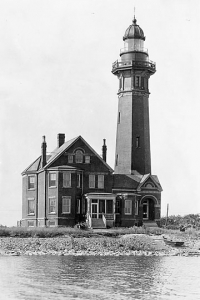 Lighthouse Beach circa 1920.
Lighthouse Beach circa 1920.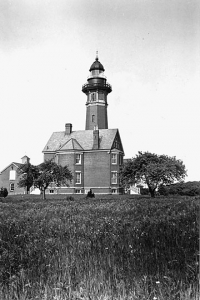 Lighthouse Beach is just west of Ampor Beach and was part of the original James Worbois 76 acre farm that included the famed “Bogus Point,” a spot noted on the Parma 1852 map where Lake Ontario juts south from the regular shoreline. There have been myths and rumors over the years that it was a favorite hideout for “bootleggers” and in earlier times, a secret hiding place for ill gotten contraband, and a smugglers paradise.
Lighthouse Beach is just west of Ampor Beach and was part of the original James Worbois 76 acre farm that included the famed “Bogus Point,” a spot noted on the Parma 1852 map where Lake Ontario juts south from the regular shoreline. There have been myths and rumors over the years that it was a favorite hideout for “bootleggers” and in earlier times, a secret hiding place for ill gotten contraband, and a smugglers paradise.
In 1896, the United States Government purchased 5 and one-half acres from Mr. Worbois to build what would become the tallest lighthouse with the brightest light on Lake Ontario. Several miles out in the lake are shoals where over the years ships were known to get wrecked during stormy weather or during periods when the lake was at a very low level. The light from the lighthouse warned ships travelling at night to stay at a respectable distance from the shoreline and guided them into Charlotte Harbour. In 1924, according to the map, the Worbois property was owned by Mr. Edwin J. Street who built a road to the south of the lighthouse and sold lots on both sides of the road and on the frontage to the east of “Bogus Point.” Along this road is the famous Parma octagon-cottage built by Mr. B. Aylesworth Haines, noted Hilton artist, in the 1920’s. Mr. Haines, inspired by a French and Indian War era “fleur de lis” military button he found on the shore, built the cottage in the popular “arts and craft” style. The fireplace is central to the design with a “fleur de lis” as the decoration, and the rooms were carefully built around the fireplace in an octagonal plan. The house is registered with the Landmark Society of Western New York as an important piece of architecture to the region. It has also been recorded that Henry Ford and George Firestone stopped by to see the unusual cottage on one of their trips to their Great Camps in the Adirondacks. Their signatures were recorded in Mr. Haines’s guest book but, alas, that has disappeared with time.
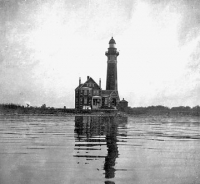 The Lighhouse from the water early on, showing the building on its five original acres, before development occurred. Adjacent to the Lighthouse on the west side is Parma’s only waterfront park which is about one-sixth of an acre in size.The Braddock Point Lighthouse is perhaps the most significant historic architectural structure in the town of Parma. For many years Parma residents would visit the lighthouse on Sunday afternoons, climb up the 97’ tower and be amazed by the views up and down the Parma shoreline. Frank Coleman was an early lighthouse keeper, and he and his family had a tradition of welcoming Parma residents and their friends to the lighthouse on sunny summer Sunday afternoons. Church picnics were held at the Lighthouse on a regular basis. It was an integral part of the community. In 1956 the light was no longer needed, and because of deterioration, the old tower was sadly dismantled, and the lighthouse keeper’s brick Victorian house left to the wind. Fortunately in the 1960s the house was restored, and today it is a popular bed and breakfast enterprise. Today, guests travel to Parma’s Lighthouse from Europe, California, and Toronto. Many lighthouse enthusiasts find it a wonderful opportunity to be able to spend a few nights in the Lighthouse and enjoy the hospitality of proprietors Don and Nancy Town.
The Lighhouse from the water early on, showing the building on its five original acres, before development occurred. Adjacent to the Lighthouse on the west side is Parma’s only waterfront park which is about one-sixth of an acre in size.The Braddock Point Lighthouse is perhaps the most significant historic architectural structure in the town of Parma. For many years Parma residents would visit the lighthouse on Sunday afternoons, climb up the 97’ tower and be amazed by the views up and down the Parma shoreline. Frank Coleman was an early lighthouse keeper, and he and his family had a tradition of welcoming Parma residents and their friends to the lighthouse on sunny summer Sunday afternoons. Church picnics were held at the Lighthouse on a regular basis. It was an integral part of the community. In 1956 the light was no longer needed, and because of deterioration, the old tower was sadly dismantled, and the lighthouse keeper’s brick Victorian house left to the wind. Fortunately in the 1960s the house was restored, and today it is a popular bed and breakfast enterprise. Today, guests travel to Parma’s Lighthouse from Europe, California, and Toronto. Many lighthouse enthusiasts find it a wonderful opportunity to be able to spend a few nights in the Lighthouse and enjoy the hospitality of proprietors Don and Nancy Town.
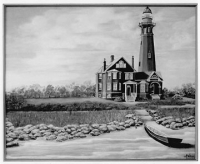 A photo of a painting of Braddock Bay Light created by Annette Wilcox in 1960.Parma’s lakeshore is abundant with history, and interesting memories of days gone by. These are just a few. If any reader has additional information to share, it would be welcomed by the Village of Hilton Historian’s Office at 59 Henry Street as we continue to record that special part of our community’s story.
A photo of a painting of Braddock Bay Light created by Annette Wilcox in 1960.Parma’s lakeshore is abundant with history, and interesting memories of days gone by. These are just a few. If any reader has additional information to share, it would be welcomed by the Village of Hilton Historian’s Office at 59 Henry Street as we continue to record that special part of our community’s story.
A final note from Historian Dave Crumb: This series would not have been possible without the excellent historic files that have been saved, organized and developed by previous Hilton village historians through the donations and writings of Parma residents. Also special thanks to Charles Nichols for his assistance in digitizing many old photos shown in the series that have never previously been seen.


